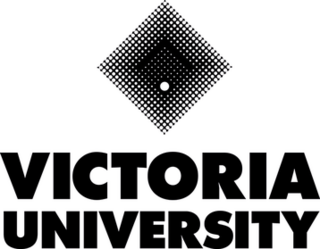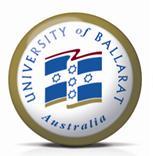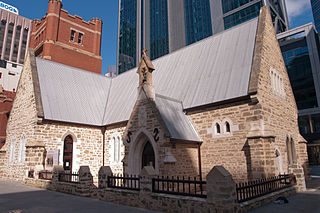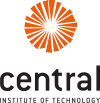
Perth is the capital city of Western Australia. It is the fourth most populous city in Australia, with a population of over 2.3 million within Greater Perth as of 2023. It is part of the South West Land Division of Western Australia, with most of Perth's metropolitan area on the Swan Coastal Plain between the Indian Ocean and the Darling Scarp. The city has expanded outward from the original British settlements on the Swan River, upon which its central business district and port of Fremantle are situated.
Technical and further education or simply TAFE is the common name in Australia for vocational education, as a subset of tertiary education. TAFE institutions provide a wide range of predominantly vocational courses. Colloquially also known as "Tech".

Victoria University is a public research university based in Melbourne, Victoria, Australia. It is a dual-sector university, providing courses in both higher education and technical and further education (TAFE).

Curtin University is an Australian public research university based in Bentley, Perth, Western Australia. It is named after John Curtin, Prime Minister of Australia from 1941 to 1945, and is Western Australia's largest university, with 58,607 students in 2022.
TAFE NSW is an Australian vocational education and training provider. Annually, the network trains over 500,000 students in campus, workplace, online, or distance education methods of education. It was established as an independent statutory body under the TAFE Commission Act 1990. The Minister for Regional Development, Skills and Small Business is responsible for TAFE NSW.
The Canberra Institute of Technology (CIT) is a vocational education provider with five campuses located in Canberra, Australian Capital Territory. CIT is the largest Technical and Further Education (TAFE) provider in the Australian Capital Territory. Qualifications offered by CIT range from certificate to degree level. CIT has campuses across Canberra, located in Bruce, Reid, and Fyshwick. CIT also has two learning centres in Tuggeranong Town Centre and Gungahlin, which are primarily for students studying via flexible or distance learning. A Woden campus is currently under construction, due to be completed in 2025. CIT provides a wide range of education and training courses that focus on practical skills and formal, technical qualifications.
Melbourne Polytechnic, formerly NMIT, is an institute of higher education and vocational education (TAFE) located in Melbourne, Australia that has been operating since around 1910.

The University of Ballarat, Australia was a dual-sector university with multiple campuses in Victoria, Australia, including its main Ballarat campus, Melbourne, Sydney, and Adelaide that were authorized by the university to provide diploma, undergraduate and postgraduate programs. The university offered traditional programs, including business, information technology, building and construction, engineering, mining, education, social sciences, nursing, hospitality, and art.
Metropolitan South Institute of TAFE was a progressive, public provider of technical and further education college within Queensland, Australia. MSIT operated in the highly competitive vocational education and training sector. The college offered 270 courses for approx 30,000 students enrolled each year. MSIT also provided fee for service corporate training and small business coaching programs.

Perth Institute of Contemporary Arts (PICA) is a contemporary visual and performance arts venue located in a heritage-listed building in Perth, Western Australia.

Education in Western Australia consists of public and private schools in the state of Western Australia, including public and private universities and TAFE colleges. Public school education is supervised by the Department of Education, which forms part of the Government of Western Australia. The School Curriculum and Standards Authority is an independent statutory authority responsible for developing a curriculum and associated standards in all schools, and for ensuring standards of student achievement, and for the assessment and certification according to those standards.

The Old Perth Boys School, located at 139 St Georges Terrace, Perth, Western Australia, is the earliest government school building in Western Australia. The single-storey limestone building was designed by William Ayshford Sanford in 1852 and is a significant example of a colonial building constructed in Perth from the mid-nineteenth century.

The 1910 Perth Technical School building is located at 137 St Georges Terrace, Perth, Western Australia, adjacent to the Old Perth Boys School building, which had served as part of the school's former temporary premises since opening of classes there on 16 May 1900.
TAFE Gippsland, formerly Advance TAFE & East Gippsland Institute of TAFE is a TAFE institute located in the Gippsland region of Victoria, Australia. It has campuses located at Bairnsdale, Lakes Entrance and Sale as well as specialist education centres located across the south-east of Victoria, encompassing the Wellington Shire and East Gippsland Shire regions.

West Coast Institute is the TAFE institute servicing the northern suburbs of Perth, Western Australia. The institute, based in the Joondalup learning precinct 26 kilometres (16 mi) north of the Perth central business district, became part of North Metropolitan TAFE on 11 April 2016.
The South Metropolitan TAFE is a Technical and Further Education (TAFE) institution with campuses in Armadale, Bentley, Carlisle, Fremantle, Jandakot, Kwinana, Mandurah, Munster, Murdoch, Naval Base, Rockingham and Thornlie in Western Australia.

Polytechnic West was a State Training Provider established under section 35 of the Vocational Education and Training Act 1996 (WA) based in Perth, Western Australia. Polytechnic West is one of the largest training providers in the state and teaches and instructs in a range of areas from trade-based apprenticeships to business and finance to aviation across its eight campuses in Bentley, Carlisle, Midland, Thornlie, Balga, Jandakot and two Armadale campuses.

North Metropolitan TAFE is a state government-funded educational institution delivering Technical and Further Education (TAFE). It services the northern suburbs of Perth across ten campuses. North Metropolitan TAFE was formed on 11 April 2016, when the Government of Western Australia announced after the Independent Review of the Vocational Education and Training Sector in Western Australia, that the 11 State Training Providers would be streamlined and form five new TAFE colleges in Western Australia. This resulted in the merging of Central Institute and West Coast Institute to form North Metropolitan TAFE.



















